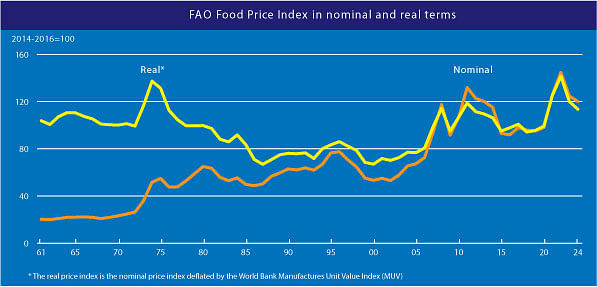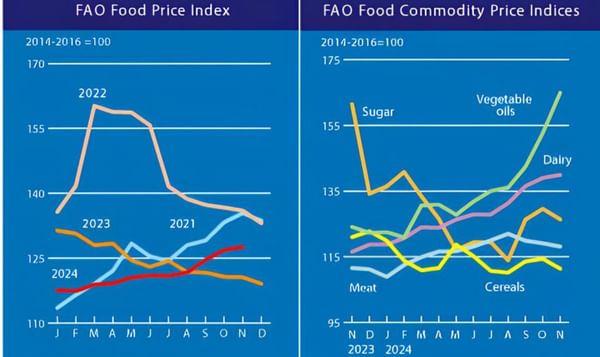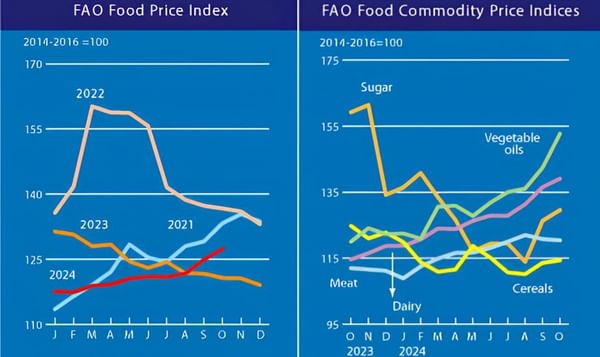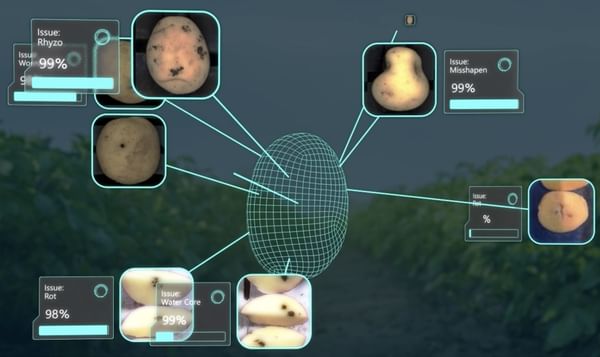Higher quotations across the board push the FAO Food Price Index up in September
Higher quotations across the board push the FAO Food Price Index up in September

The FAO Food Price Index (FFPI) stood at 124.4 points in September 2024, up 3 percent from August and marking the largest month-on-month increase since March 2022. Price quotations for all commodities included in the index strengthened, with the increases ranging from 0.4 percent for the meat price index to 10.4 percent for sugar. Compared to historical levels, the FFPI in September was 2.1 percent higher than its corresponding value a year ago but 22.4 percent below its peak of 160.3 points reached in March 2022.
The FAO Cereal Price Index averaged 113.5 points in September, up 3.3 points (3.0 percent) from August but still 12.8 points (10.2 percent) below its September 2023 value. After declining for three consecutive months, global wheat prices increased in September, largely due to concerns over unfavourable weather conditions in some key exporters.
Excessively wet conditions in Canada and the European Union caused harvest delays in the former and led to a sizeable cut to the production forecast for the latter. However, competitively-priced supplies from the Black Sea region capped the increase in prices. World maize prices also increased month-on-month, driven by low water levels on the Madeira River in Brazil and the Mississippi River in the United States of America, along with strong domestic demand in Brazil and a solid export pace in Argentina.
Among other coarse grains, world prices of barley firmed while those of sorghum dropped. The FAO All Rice Price Index declined by 0.7 percent in September, reflecting generally quiet trading activities and lower Indian basmati quotations, driven by the arrival of freshly-harvested supplies and the Indian Government's removal of the floor price used for basmati export registration.
The FAO Vegetable Oil Price Index averaged 142.4 points in September, up 6.2 points (4.6 percent) from August and reaching its highest level since early 2023. The continued rise of the price index was driven by higher quotations across palm, soy, sunflower and rapeseed oils.
International palm oil prices rose for the fourth consecutive month in September, underpinned mainly by concerns over lower-than-expected production that coincided with anticipated seasonal output declines in major Southeast Asian producing countries. Meanwhile, world soyoil quotations rebounded, due primarily to lower-than-expected crushings in the United States of America. As for sunflower and rapeseed oils, the marginal price recoveries in September were supported by a tightening supply outlook, following reduced outputs of respective oilseeds in the 2024/25 season.
The FAO Dairy Price Index averaged 136.3 points in September, an increase of 5.0 points (3.8 percent) from August and 24.3 points (21.7 percent) higher than its corresponding value a year ago. The rise in the index was driven by higher prices across all dairy products, with whole milk powder prices rising the most, spurred by strong import demand in Asia, despite seasonally higher milk production in Oceania.
Skim milk powder prices rose due to limited export availabilities amid tight milk supplies and robust domestic purchases in Western Europe. Meanwhile, world butter prices increased for the eleventh consecutive month, underpinned by solid import and domestic demand, tight inventories and limited milk supplies in Western Europe. World cheese prices also increased, reflecting strong global import demand and tight exportable availabilities in Western Europe, where milk production is seasonally lower.
The FAO Meat Price Index* averaged 119.6 points in September, up 0.4 points (0.4 percent) from August and 5.5 points (4.8 percent) higher than its value a year ago. The rise in the index was driven by higher poultry meat prices, primarily reflecting strong import demand for Brazilian poultry meat following the easing of trade restrictions related to the Newcastle disease.
Meanwhile, international bovine meat prices remained stable, as limited supplies from leading producing countries were sufficient to meet global import demand. Similarly, world pig meat prices were unchanged, with global supplies adequately covering increased demand, including higher domestic sales in the European Union. By contrast, international ovine meat prices fell marginally, largely due to continued weak import demand from China.
The FAO Sugar Price Index averaged 125.7 points in September, an increase of 11.9 points (10.4 percent) from August, but still 37 points (22.7 percent) lower than its value a year ago. The increase in September was driven by concerns over tighter global availabilities in the upcoming 2024/25 season.
Worsening crop prospects in Brazil, due to prolonged dry weather and fires that damaged sugarcane fields in late August, were the main drivers of the increase in global sugar prices. Additionally, concerns that India’s sugar export availability could be affected by the government's decision to lift restrictions on sugarcane use for ethanol production also contributed to the overall increase in world sugar prices.

FAO Food Price Index in nominal and real terms











